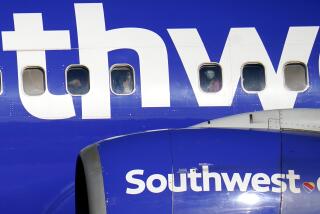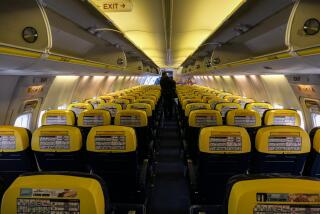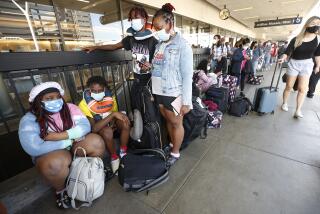Airlines Want to Lighten the Heavy Carry-On Load
Hard on the heels of the heavily trafficked holiday season, Northwest and United airlines say they’re making gains in the fight against carry-on baggage proliferation. Their common strategy: to squeeze most coach passengers more tightly while leaving those in pricier seats largely undisturbed.
The airlines say their approaches are good news for the many travelers who are fed up with following carry-on rules, only to be inconvenienced by seatmates who have ignored them and brought three or four hefty bags aboard. But the controversy is far from over.
Flight attendants, who view this as a serious safety issue, say these individual initiatives may confuse travelers further, and that a real solution can only come with strict regulation--not just suggested guidelines--from the Federal Aviation Administration. And the jury’s still out on how well we consumers will like the idea of making cabin baggage a matter of class.
What the feds say: By some estimates, as many as 4,000 passengers yearly are injured in cabin-baggage mishaps. An FAA spokeswoman acknowledged that “we’ve never really defined whether purses and laptops and such count as carry-on baggage. There’s a better definition needed.” So in November the agency unveiled a set of proposed guidelines and asked for industry and public input (through March 1). Among the proposed guidelines: “Some airlines might want to restrict passengers to one bag per passenger with an additional small item, such as a purse or briefcase.” Suggested total carry-on weight limit: 20 pounds.
But these are only proposed guidelines. The FAA has long allowed airlines to set their own specific baggage policies, subject to general approval. An FAA spokeswoman explained that “equipment varies from airline to airline, and cabin configurations vary.” For more than a decade, that spokeswoman added, the agency has had a clear bottom-line requirement about keeping aisles clear and baggage stowed securely overhead and underfoot. The details of achieving that bottom line, she said, are a retail issue that the federal government shouldn’t have to decide.
But at the Assn. of Flight Attendants headquarters in Washington, D.C., spokeswoman Jill Gallagher asserted that “the FAA needs to come up with standardized, uniform regulations that would cover every airline. . . . These new policies are reinforcing the competitive [approach to the] issue” and may confuse consumers further.
Most domestic carriers generally limit passengers to two bags (so long as each fits under a seat or into an overhead compartment) but leave unaddressed the question of purses and other smaller items. But throughout the industry, enforcement has long been lax. Many passengers routinely ignore plainly posted airline limits. As flights have become more crowded in the current economic boom, space has been tight, and tempers short.
What the airlines found: Into this controversy stepped Northwest Airlines, shortly before Thanksgiving, with a bold policy change. Instead of allowing passengers up to two carry-ons plus purses or briefcases, the carrier announced that coach-class passengers would be limited to one carry-on bag plus one small item, such as a purse, a laptop computer or a briefcase. First- and business-class travelers, however, are allowed two carry-ons plus purse or briefcase, as are travelers with the airline’s most elite frequent-flier status.
The trial by traffic began days later. The airline had its busiest December ever, with 4.46 million passengers boarded. And?
“We have been pleasantly surprised by how little dissent we have received from our passengers,” said Northwest spokesman John Austin.
United Airlines tackled the issue with a test for flights leaving Des Moines. In that experiment, passengers face basically the same restrictions as Northwest’s.
“The feedback has been really positive, from our employees as well as customers,” reported United spokeswoman Mary Jo Holland. She said the test will continue.
Facts to remember: For the record, U.S. Transportation Department statistics show that in the first nine months of last year, slightly more than 199 of every 200 U.S. passengers reached their destination on the same flight that their checked baggage did, a slight improvement over the year before. Of the bags that didn’t arrive on the same flight, the Air Transport Assn. (a Washington-based trade group) estimates that four of every five were reunited with their owners within 24 hours of arrival. Overall, the group estimates, just one in 20,000 checked bags is irretrievably lost or stolen. In five years of frequent flying and 12 years of casual flying before that, I’ve twice, perhaps three times, had bags delayed more than 12 hours, and never had one lost.
Bottom line: Many travelers who claim to be worried about their bags’ security may really be more worried about saving half an hour on their way out of the airport. Even without speeding up the unloading process, if airlines enforced their own policies more stringently and invested a little more money in sprucing up dismal baggage-collection areas, might this entire controversy simmer down?
Reynolds travels anonymously at the newspaper’s expense, accepting no special discounts or subsidized trips. He welcomes comments and suggestions, but cannot respond individually to letters and calls. Write Travel Insider, Los Angeles Times, Times Mirror Square, Los Angeles 90053 or e-mail [email protected].
More to Read
Inside the business of entertainment
The Wide Shot brings you news, analysis and insights on everything from streaming wars to production — and what it all means for the future.
You may occasionally receive promotional content from the Los Angeles Times.











